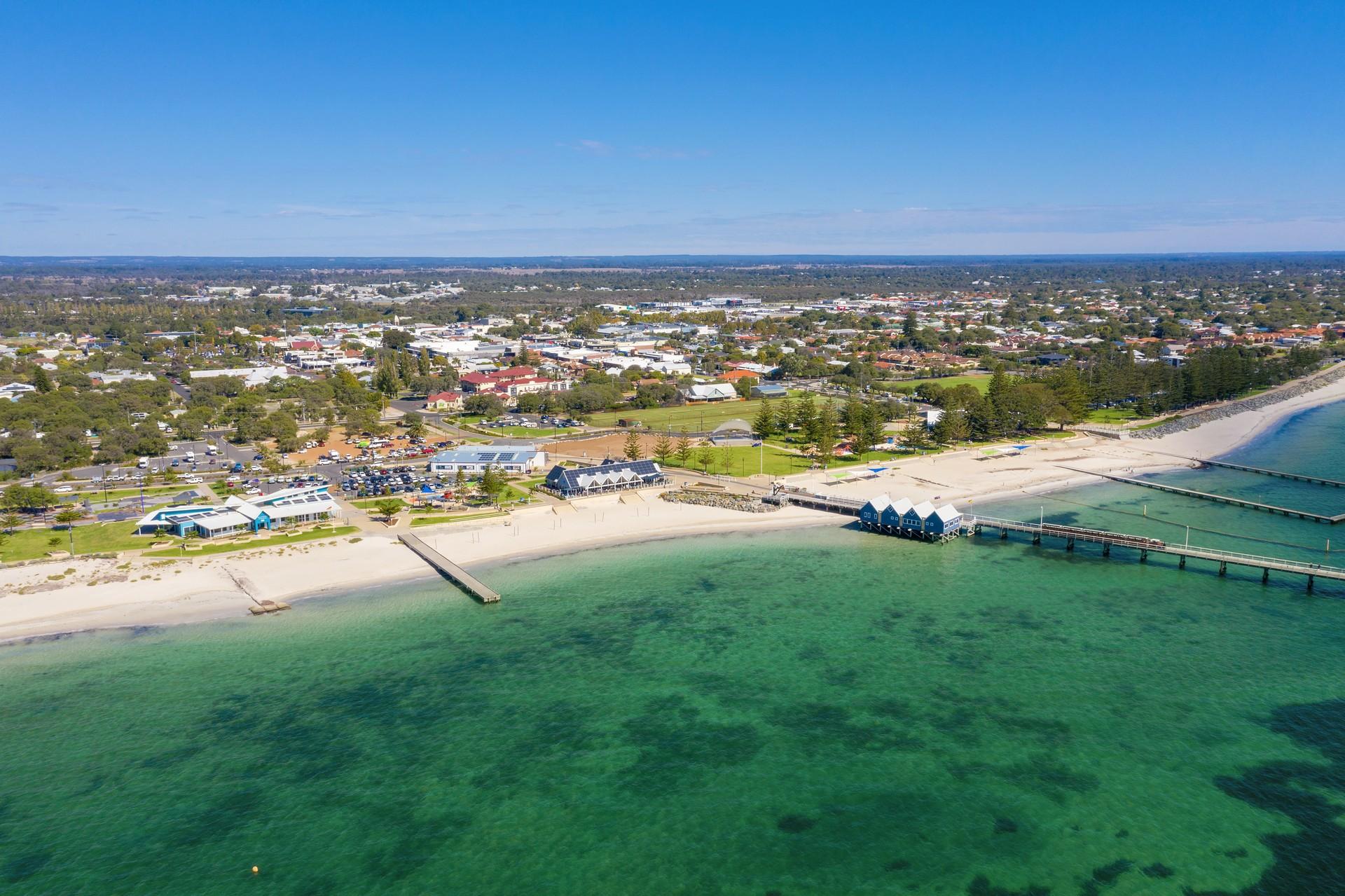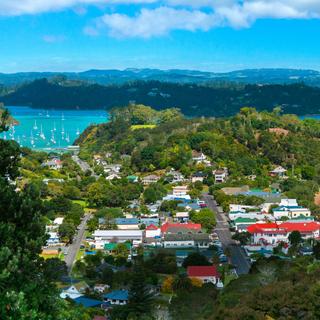
Busselton weather and climate

Busselton weather and climate
Day
21 °C
Night
12 °C
Sea
20 °C
Precipitation
110 mm
in month
Rainy days
13 days
in month
Daylight
10 hours
average
Sunshine
5 hours
average
Humidity
68 %
Travel information


Weather charts for Busselton

Find more destinations like this
Destinations with similar weather to Busselton
Other destinations in Western Australia
Closest cities for Busselton
Weather overview for Busselton
Weather overview
Located in beautiful Australia, Busselton experiences a variety of climatic conditions throughout the year. Daytime temperatures fluctuate between 18 °C (64 °F) degrees in the cooler month of July, to a warm 29 °C (85 °F) degrees at the height of summer in January. Sea temperatures peak in March, hitting a high of 21 °C (70 °F), before dipping to their lowest point in September at 17 °C (63 °F). January is the driest period with just 2 days of rain, while July opposes with the most rainfall, marked by 19 days. Night temperatures offer a cooler respite from the heat ranging from 9 °C (49 °F) degrees in August to a comfortable 16 °C (60 °F) in February.
January weather
January in Busselton shows the highest daytime temperatures at 29 °C (85 °F), while sea temperatures continue to rise, peaking at 21 °C (69 °F). Tourists flock to the region during this peak season. Rain is scarce, with a minimal 2 days of precipitation, and sunlight is abundant, boasting up to 10 hours hours.
February weather
February in Busselton ushers in a gradual change, although it remains a popular time for visitors. Nighttime temperatures reach their zenith this month. Winds also blow at their strongest now. Sunlight gradually starts to decrease.
March weather
Tourism remains vibrant in March as Busselton sees daytime temperatures begin to dip slightly, with an average of 28 °C (82 °F). The sea beckons with its warmest temperatures of the year. The early signs of increased rainfall are seen, totaling 20 mm (0.79 in). Nighttime temperatures also start to decrease, evident with an average of 15 °C (59 °F). Sunshine becomes less frequent, dropping to 8 hours.
April weather
As tourist activities begin to wane in April, Busselton's daily temperatures continue to descend, registering 24 °C (76 °F). Sea temperatures start their decline as well, averaging 21 °C (69 °F). The nights grow colder, with 13 °C (56 °F). A decline in sunny hours to 6 hours accompanies a rise in rainy days with an average of 8 days.
May weather
In May, both daytime and sea temperatures in Busselton continue their downward trend, registering 20 °C (68 °F) for the sea. Tourist season remains at its peak. The number of rainy days continues to rise. The wind is at its calmest, averaging 4 m/s. Nights get increasingly cooler, now 12 °C (53 °F).
June weather
June in Busselton brings cooler day temperatures averaging 19 °C (66 °F) and a continued reduction in sea temperatures to 19 °C (67 °F). Rainy days increase as expected, reaching 18 days, with a substantial rise in rainfall to 154 mm (6.08 in). The trend of the least sunny hours persists, marking the onset of the wet season.
July weather
Busselton experiences the coldest daytime temperatures in July, noted at 18 °C (64 °F). A similar decrease is seen in sea temperatures, now 18 °C (65 °F). The wet season intensifies with the highest number of rainy days at 19 days and peak rainfall amounts reaching 159 mm (6.27 in). Humidity is at its maximum, averaging 74 %.
August weather
August sees Busselton nearing the height of its wet season. Sea temperatures continue their descent, averaging 17 °C (63 °F), whereas nighttime temperatures hit their lowest at 9 °C (49 °F). The decline in rainy days begins, settling at 17 days, while rainfall starts to reduce, now 120 mm (4.74 in). Sunlight hours make a return, increasing from the previous month.
September weather
September in Busselton marks a gradual transition with rising day temperatures, now 19 °C (66 °F), and the sea temperature at its annual low of 17 °C (63 °F). The rainy days also begin to subside, with an average of 14 days. Reduction in rainfall volume can be observed, marked at 83 mm (3.29 in). The wet season still persists, but sunshine hours continue to increase.
October weather
October sees a continuation of milder weather conditions in Busselton. Day temperatures steadily rise to 21 °C (70 °F), and the number of rainy days decreases noticeably to 9 days. Rainfall continues on a downtrend, now at 41 mm (1.61 in). Sunny hours grow in number, recorded at 8 hours.
November weather
As November heralds the approach of tourist season once more, sea temperatures begin their rise, charting 19 °C (66 °F). Day temperatures increase too, reaching a comfortable 24 °C (75 °F). The dwindling of rainy days continues, now at 6 days, and rainfall also sees a continued reduction, calculated at 32 mm (1.25 in). Nighttime temperatures begin to warm up slightly.
December weather
December heralds the full swing of Busselton's tourist season, with day temperatures climbing up to a pleasurable 27 °C (80 °F) and sea temperatures making a similar ascent, averaging 20 °C (68 °F). The decline in rainy days persists, and rainfall also tapers off, with a figure of 14 mm (0.56 in). Nighttime temperatures continue to warm, registering 13 °C (56 °F).
FAQs
What is the average sea temperature in Busselton during January?
In January, Busselton's sea temperature averages 21 °C (69 °F), providing a pleasantly cool escape from the heat.
Is February a hot month in Busselton?
Yes, Busselton in February is characteristically warm, yet the temperatures remain agreeable for outdoor activities.
Does March experience a lot of rainfall in Busselton?
March in Busselton has moderate rainfall, with an average of 4 days days of precipitation.
What is the likelihood of rain in April in Busselton?
April sees a good chance of rain in Busselton, with an estimated 8 days days expected to be wet.
How many hours of sunlight should I expect in Busselton during May?
Busselton offers around 5 hours hours of sunshine in May.
As winter approaches, how will temperatures change in Busselton in June?
June's approach to winter in Busselton signifies a drop in temperatures, both sea and air, foreshadowing a cooler climate.
How does the wet season peak affect Busselton in July?
July marks the climax of Busselton's wet season, with maximum rainfall and the highest number of rainy days.
What are the expected climatic conditions in Busselton during August?
Expect continuing wet conditions with a slight reduction in rainfall and the coldest nights of the year in August.
With the wet season ongoing, how much rain should I expect in Busselton in September?
In September, rain begins to lessen in Busselton with a decrease in both the number and severity of rainy days.
What type of night weather is typical in Busselton during October?
Nights in October in Busselton are cooler but not cold, ideal for outdoor evenings with appropriate attire.
What will the daytime temperatures be like in Busselton during November?
November in Busselton offers delightful daytime temperatures averaging around 24 °C (75 °F), ideal for a variety of outdoor activities.
Is December a suitable month for planning a visit to Busselton?
Definitely, December's lovely climate in Busselton makes it an ideal time for a visit, given the warm days and sparse rainfall.




